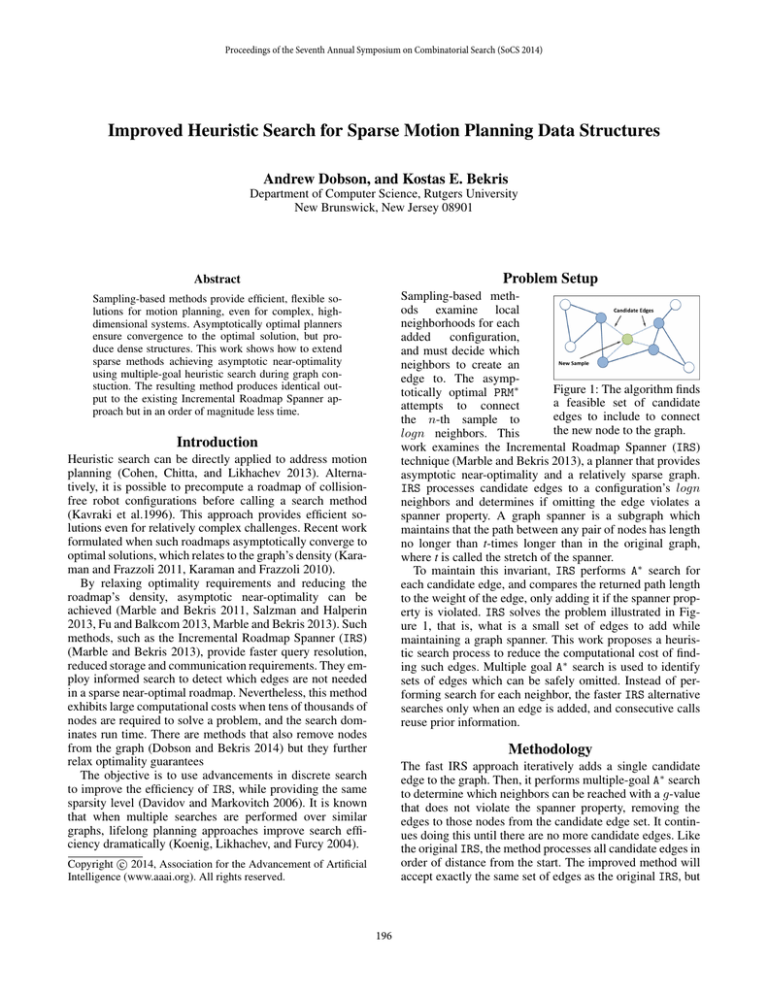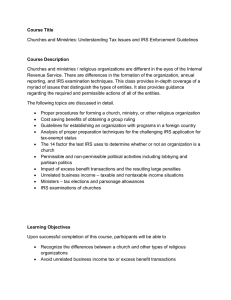
Proceedings of the Seventh Annual Symposium on Combinatorial Search (SoCS 2014)
Improved Heuristic Search for Sparse Motion Planning Data Structures
Andrew Dobson, and Kostas E. Bekris
Department of Computer Science, Rutgers University
New Brunswick, New Jersey 08901
Abstract
Problem Setup
Sampling-based methods provide efficient, flexible solutions for motion planning, even for complex, highdimensional systems. Asymptotically optimal planners
ensure convergence to the optimal solution, but produce dense structures. This work shows how to extend
sparse methods achieving asymptotic near-optimality
using multiple-goal heuristic search during graph constuction. The resulting method produces identical output to the existing Incremental Roadmap Spanner approach but in an order of magnitude less time.
Sampling-based methods examine local
neighborhoods for each
added
configuration,
and must decide which
neighbors to create an
edge to. The asympFigure 1: The algorithm finds
totically optimal PRM∗
a feasible set of candidate
attempts to connect
edges to include to connect
the n-th sample to
the new node to the graph.
logn neighbors. This
work examines the Incremental Roadmap Spanner (IRS)
technique (Marble and Bekris 2013), a planner that provides
asymptotic near-optimality and a relatively sparse graph.
IRS processes candidate edges to a configuration’s logn
neighbors and determines if omitting the edge violates a
spanner property. A graph spanner is a subgraph which
maintains that the path between any pair of nodes has length
no longer than t-times longer than in the original graph,
where t is called the stretch of the spanner.
To maintain this invariant, IRS performs A∗ search for
each candidate edge, and compares the returned path length
to the weight of the edge, only adding it if the spanner property is violated. IRS solves the problem illustrated in Figure 1, that is, what is a small set of edges to add while
maintaining a graph spanner. This work proposes a heuristic search process to reduce the computational cost of finding such edges. Multiple goal A∗ search is used to identify
sets of edges which can be safely omitted. Instead of performing search for each neighbor, the faster IRS alternative
searches only when an edge is added, and consecutive calls
reuse prior information.
Introduction
Heuristic search can be directly applied to address motion
planning (Cohen, Chitta, and Likhachev 2013). Alternatively, it is possible to precompute a roadmap of collisionfree robot configurations before calling a search method
(Kavraki et al.1996). This approach provides efficient solutions even for relatively complex challenges. Recent work
formulated when such roadmaps asymptotically converge to
optimal solutions, which relates to the graph’s density (Karaman and Frazzoli 2011, Karaman and Frazzoli 2010).
By relaxing optimality requirements and reducing the
roadmap’s density, asymptotic near-optimality can be
achieved (Marble and Bekris 2011, Salzman and Halperin
2013, Fu and Balkcom 2013, Marble and Bekris 2013). Such
methods, such as the Incremental Roadmap Spanner (IRS)
(Marble and Bekris 2013), provide faster query resolution,
reduced storage and communication requirements. They employ informed search to detect which edges are not needed
in a sparse near-optimal roadmap. Nevertheless, this method
exhibits large computational costs when tens of thousands of
nodes are required to solve a problem, and the search dominates run time. There are methods that also remove nodes
from the graph (Dobson and Bekris 2014) but they further
relax optimality guarantees
The objective is to use advancements in discrete search
to improve the efficiency of IRS, while providing the same
sparsity level (Davidov and Markovitch 2006). It is known
that when multiple searches are performed over similar
graphs, lifelong planning approaches improve search efficiency dramatically (Koenig, Likhachev, and Furcy 2004).
Methodology
The fast IRS approach iteratively adds a single candidate
edge to the graph. Then, it performs multiple-goal A∗ search
to determine which neighbors can be reached with a g-value
that does not violate the spanner property, removing the
edges to those nodes from the candidate edge set. It continues doing this until there are no more candidate edges. Like
the original IRS, the method processes all candidate edges in
order of distance from the start. The improved method will
accept exactly the same set of edges as the original IRS, but
c 2014, Association for the Advancement of Artificial
Copyright Intelligence (www.aaai.org). All rights reserved.
196
determines this set at a much faster rate. Asymptotic analysis
of this new method is omitted here, as the running time depends on the number of edges retained. Characterizing how
many edges the IRS method retains is an open problem but
does not correspond to the optimal.
Figure 2 (Right), the optimized version of IRS runs an order
of magnitude quicker than the original, greatly improving its
practical applicability. To exemplify this, the method is also
tested in a robot manipulation framework, to solve pick-andplace tasks on a shelf, shown in Figure 3 (Left). Note that the
two approaches produce the same graph and return the same
solutions, but with vastly different runtimes.
Algorithm 1: multi-A∗ (G, start, N, t)
1 ∀u : Color[u] == BLACK, Color[u] := GRAY ;
2 O ← O ∪ {start}; reached ← ∅;
3 while O 6= ∅ and N 6= ∅ do
4
u ← remove min(O);
5
if u ∈ N then
6
if g(u) < t · |start, u| then
7
reached ← reached ∪ {u};
8
N ← N \ {u};
9
Update h(·) in O;
10
O ← expand(u);
11
Color[u] := BLACK;
12 return reached;
Figure 3: The manipulation benchmark, which also shows
great improvement in running time.
Conclusion
Using a more intelligent search, computing sparse planning
structures can be made much more efficient. This work provides a multi-target, incremental method to speed up IRS by
an order of magnitude. Future work will cast the problem in
an optimization framework, attempting to find the minimal
set of edges to add to the graph.
The multi-goal A∗ approach is given in Algorithm 1. Line
1 ensures that nodes expanded in the previous iteration are
marked gray, so that the search is able to explore through
these nodes. Then, the start state is put into the open set, and
reached goals are reset (Line 2). Then, the A∗ search continues until either the open set is empty, or all of the goals
have been reached (Line 3). Then, if the minimum element
of the open set O is a goal (Line 5), it is checked for the
spanner property (Line 6), and if it satisfies the property, the
element is added to the reached set of goals (Line 7). Then, it
is removed from the goal set (Line 8), and the heuristics for
all elements in the open set are updated (Line 9). Whether
the node was a goal or not, it is then expanded in the same
fashion as a standard A∗ search (Line 10) and marked black,
indicating its expansion (Line 11). The algorithm returns all
goals which were reached while satisfying the spanner property (Line 12).
References
Cohen, B.; Chitta, S.; and Likhachev, M. 2013. Heuristic
Search-based Planning for Manipulation. International Journal of
Robotics Research (IJRR).
Davidov, D., and Markovitch, S. 2006. Multiple-Goal Heuristic
Search. Journal of Artificial Intelligence Research 26:417–451.
Dobson, A., and Bekris, K. E. 2014. Sparse Roadmap Spanners
for Asymptotically Near-Optimal Motion Planning. IJRR 33.
Fu, W., and Balkcom, D. 2013. A fast streaming spanner algorithm
for incrementally constructing sparse roadmaps. In IEEE/RSJ Intern. Conf. on Intelligent Robots and Systems (IROS).
Karaman, S., and Frazzoli, E. 2010. Incremental Sampling-based
Algorithms for Optimal Motion Planning. In RSS.
Karaman, S., and Frazzoli, E. 2011. Sampling-based Algorithms
for Optimal Motion Planning. IJRR 30(7):846–894.
Kavraki, L. E.; Svestka, P.; Latombe, J.-C.; and Overmars, M.
1996.
Probabilistic Roadmaps for Path Planning in HighDimensional Configuration Spaces. IEEE TRA 12(4):566–580.
Koenig, S.; Likhachev, M.; and Furcy, D. 2004. Lifelong Planning
A*. Artificial Intelligence Journal 155(1-2):93–146.
Marble, J. D., and Bekris, K. E. 2011. Asymptotically NearOptimal is Good Enough for Motion Planning. In ISRR.
Marble, J., and Bekris, K. E. 2013. Asymptotically Near-Optimal
Planning with Probabilistic Roadmap Spanners. IEEE Transactions on Robotics 29:432–444.
Salzman, O., and Halperin, D. 2013. Asymptotically Near-Optimal
RRT for Fast, High-quality Motion Planning. Technical report,
arXiv.
Experimental Validation
Figure 2: The simple Barriers benchmark for testing the improvements to IRS, showing much lower running time.
The benefits of the approach are validated against the
original IRS implementation. First, as a baseline, the IRS
methods are tested in a simple rigid body setup (Barriers),
illustrated in Figure 2 (Left), which is a rather standard challenge in motion planning. The main performance measure
tested is the running time for the algorithms. As shown in
197




